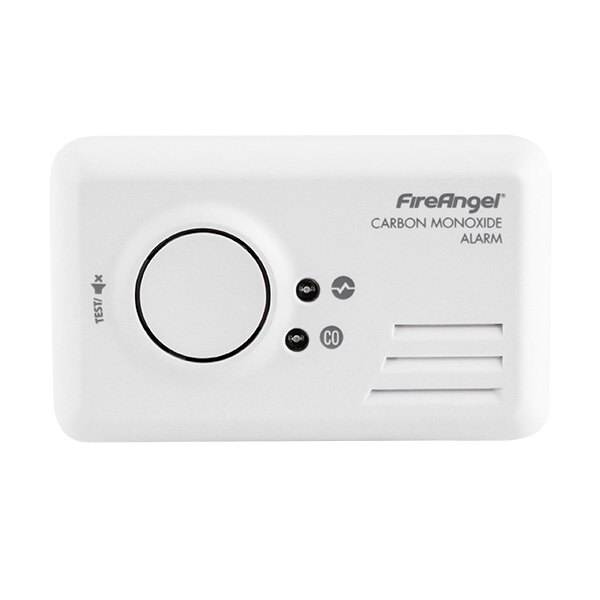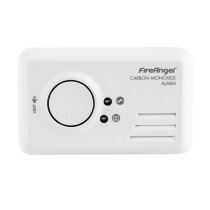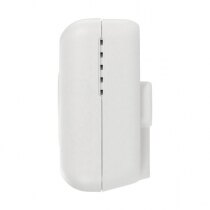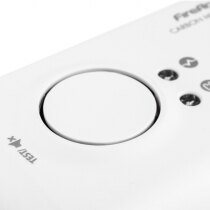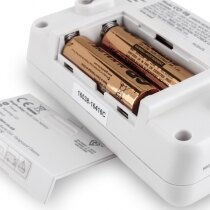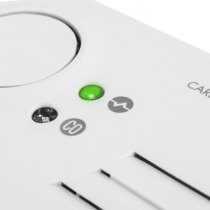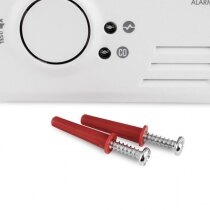7 Year Life LED Carbon Monoxide Alarm - FireAngel CO-9B
Discontinued Product
This product has been discontinued.
Ideal for home and travel use, the FireAngel CO-9B carbon monoxide alarm is suitable for wall mounting or free standing as a portable device. The FireAngel CO-9B has a 7 year lifespan and is supplied as standard with 2 x AA alkaline batteries to power the alarm. Its LED status indicators show when the alarm is correctly powered as well as when it has entered alarm mode.
- Product Life: 7 years
- Battery: AA alkaline batteries included
- Warranty: 1 year warranty
- Designed for wall mounting with simple installation
- CE marked and Kitemarked to BS EN 50291-1 (domestic use) & BS EN 50291-2:2010 (camping/caravans/boats)
- Test/reset button feature
- Activates when CO level reaches 50ppm
- Enables users to carry out a practical sensor test
- 85dB audible alarm as well as LED status indicator
- Automatic self diagnostic function - checks its own sensor and battery
- Can be wall mounted or left free standing
- Certified for home, camping, caravan, motor home and boat use
- Supplied with fixings; 2 x screws and 2 x rawl plugs
- This alarm is also suitable for the updated 2022 Welsh legislation
| Product Code | FACO9B |
|---|---|
| Alternative Product Codes | CO-9B, CO9B |
| Brand | FireAngel |
| Battery Type | 2 x AA alkaline batteries |
| Dimensions (HxWxD) | 67x109x38mm |
| Display | LED Indicators |
| Operating Temperature | -10°C to +40°C |
| Relative Humidity | 30% to 90% |
| Sensitivity | 50ppm (parts per million) |
| Sound Output | 85dB |
| Warranty | 1 years |
| Weight | 0.17kg |
| Product Datasheets |
There is no legal or BSI requirement to test the CO detectors with a test gas. A weekly check with the test button is fully sufficient if you choose a quality CO detector. The test gas is offered as a 'belts and braces' option.
Yes, this CO alarm has been Kitemarked to EN 50291-1: 2010 and has been awarded a CE mark. It should be installed in line with the manufacturers guidance.
CO detectors should be installed near potential sources of carbon monoxide, essentially any fuel-burning appliances such as boilers, cookers and ovens, fireplaces (both open and enclosed burners), and portable generators. As you are likely to be most affected by CO in areas of your home that you spend the most time in it is advisable to install alarms in those areas as well, such as the living room and bedrooms. It is also worth noting that while one detector is better than no detectors at all, larger homes may require several detectors to cover the property fully.
Also note that carbon monoxide has been proven to spread into neighbouring properties through open windows and, in semi-detached or terrace houses, through loft spaces. If your property has an attached garage with a connecting door through to the house, it is recommended to fit a CO alarm inside the house leading from that doorway.
Battery powered carbon monoxide alarms can typically be installed wall-mounted or left free-standing on flat, level surface.
- Near an appliance: they should be placed within 1 to 3 metres horizontally from the appliance and between the height of the appliance to 150mm below the ceiling – i.e., not above a stove where it would be in the path of steam or fumes.
- In living spaces: they should be positioned close to where the occupant's head is likely to be most of the time – e.g., on your bedside table.
Combined smoke & CO alarms or mains-powered CO alarms are typically installed on the ceiling and should be at least 30cm away from any wall, light fitting, or other obstruction.
Do not install CO alarms within 3 metres of doors or windows, above radiators, or immediately close to anything that gives off steam or fumes like a cooker or shower room. Similarly, it is not recommended to install detectors in dusty areas such as workshops or garages.
For more information, please check the manufacturer's instructions – you can download the PDF manual from the relevant product page on our site. You can also watch our video guide to positioning CO detectors.
Most legislation advises at least one carbon monoxide alarm is fitted near new or replacement fuel-burning appliances that are fixed installations, though rented properties (both social and private sector) often require CO alarms be provided by landlords even if no appliances are being installed or replaced. Examples include boilers, coal fires, wood burners, and gas ovens and cookers, though an exception is often made in legislation for gas appliances solely used for cooking.
However, any and all materials can give off CO when burning, including gas cookers. Carbon monoxide can also spread from neighbouring properties or outside sources such as vehicle fumes. Because of this, Safelincs strongly recommends the installation of carbon monoxide detectors in every home, and also at head-height in bedrooms to protect occupants while sleeping.
Landlords, please see our pages for English, Welsh, and Scottish alarms or our landlord guidance page for more information.
Key Product Features
What's Included?
Every FireAngel FACO9B is supplied with the following components.
- 1 x FireAngel CO-9B carbon monoxide alarm
- 2 x AA alkaline batteries
- 1 x Screw fixing set (screws & rawl plugs)
- 1 x Instruction manual

Approved Partner
Customer Reviews
281 customers have given this product an overall rating of 4.7 out of 5
Reviews by real customers
All of our product reviews are written by real customers that have purchased this product from us and are published without modification.Rating: 4 / 5 Stars
Reviewed by: M B
Easy to use and test
Published on: 8th March 2022
Rating: 5 / 5 Stars
Reviewed by: P F
great service
Published on: 8th September 2020
Rating: 4 / 5 Stars
Reviewed by:
Great product at a realistic price We needed a Carbon Monoxide alarm for our van we found this on Safelincs. Price was OK, we know the FireAngel brand to be good and delivery was very quick.
Published on: 26th January 2020
Looking for more information?
If you have any questions or would like more information about this product you can ask one of our specialists.
Live Chat Available Now